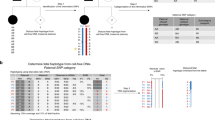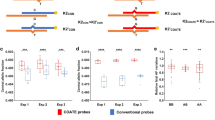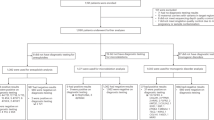Abstract
Current non-invasive prenatal screening is targeted toward the detection of chromosomal abnormalities in the fetus1,2. However, screening for many dominant monogenic disorders associated with de novo mutations is not available, despite their relatively high incidence3. Here we report on the development and validation of, and early clinical experience with, a new approach for non-invasive prenatal sequencing for a panel of causative genes for frequent dominant monogenic diseases. Cell-free DNA (cfDNA) extracted from maternal plasma was barcoded, enriched, and then analyzed by next-generation sequencing (NGS) for targeted regions. Low-level fetal variants were identified by a statistical analysis adjusted for NGS read count and fetal fraction. Pathogenic or likely pathogenic variants were confirmed by a secondary amplicon-based test on cfDNA. Clinical tests were performed on 422 pregnancies with or without abnormal ultrasound findings or family history. Follow-up studies on cases with available outcome results confirmed 20 true-positive, 127 true-negative, zero false-positive, and zero-false negative results. The initial clinical study demonstrated that this non-invasive test can provide valuable molecular information for the detection of a wide spectrum of dominant monogenic diseases, complementing current screening for aneuploidies or carrier screening for recessive disorders.
This is a preview of subscription content, access via your institution
Access options
Access Nature and 54 other Nature Portfolio journals
Get Nature+, our best-value online-access subscription
$29.99 / 30 days
cancel any time
Subscribe to this journal
Receive 12 print issues and online access
$209.00 per year
only $17.42 per issue
Buy this article
- Purchase on Springer Link
- Instant access to full article PDF
Prices may be subject to local taxes which are calculated during checkout



Similar content being viewed by others
Code availability
The customized script for the UMI-based deduplication of the NGS reads can be found at https://sourceforge.net/projects/BGNIPS.
Data availability
These authors declare that all essential data supporting the conclusion of the study as well as detailed assay protocols, analytical algorithms, and customized computational codes are within the paper and supplementary materials. All the disease-causing variants and the key phenotypes found in the subjects can be found at the ClinVar database (http://www.ncbi.nlm.nih.gov/clinvar/variation/) with accession numbers SCV000854595–SCV000854628. Subjects’ identifiable information (including their genomic sequencing data) is kept in our clinical laboratory, which is a CLIA and CAP certified laboratory and a HIPAA-compliant environment, to protect subjects’ privacy. Non-identifiable sequencing data (for example, individual variant sequencing data generated by locus-specific sequencing) can be provided on request from the authors. Source data for Fig. 1 and Extended Data Figs. 1 and 2 are available online.
Change history
20 February 2019
In the version of this article originally published, some cases that were presented in Fig. 3 should have been underlined but were not. The appropriate cases have now been underlined. The error has been corrected in the print, PDF and HTML versions of the article.
References
Norton, M. E. et al. Cell-free DNA analysis for non-invasive examination of trisomy. N. Engl. J. Med. 372, 1589–1597 (2015).
Dar, P. et al. Clinical experience and follow-up with large scale single-nucleotide polymorphism-based non-invasive prenatal aneuploidy testing. Am. J. Obstet. Gynecol. 211, 527.e1–527.e17 (2014).
Baird, P. A., Anderson, T. W., Newcombe, H. B. & Lowry, R. B. Genetic disorders in children and young adults: a population study. Am. J. Hum. Genet. 42, 677–693 (1988).
Lo, Y. M. et al. Quantitative analysis of fetal DNA in maternal plasma and serum: implications for non-invasive prenatal diagnosis. Am. J. Hum. Genet. 62, 768–775 (1998).
Chiu, R. W. et al. Non-invasive prenatal diagnosis of fetal chromosomal aneuploidy by massively parallel genomic sequencing of DNA in maternal plasma. Proc. Natl Acad. Sci. USA 105, 20458–20463 (2008).
Fan, H. C., Blumenfeld, Y. J., Chitkara, U., Hudgins, L. & Quake, S. R. Non-invasive diagnosis of fetal aneuploidy by shotgun sequencing DNA from maternal blood. Proc. Natl Acad. Sci. USA 105, 16266–16271 (2008).
Lo, Y. M. et al. Presence of fetal DNA in maternal plasma and serum. Lancet 350, 485–487 (1997).
McCullough, R. M. et al. Non-invasive prenatal chromosomal aneuploidy testing—clinical experience: 100,000 clinical samples. PLoS One 9, e109173 (2014).
Petersen, A. K. et al. Positive predictive value estimates for cell-free non-invasive prenatal screening from data of a large referral genetic diagnostic laboratory. Am. J. Obstet. Gynecol. 217, 691.e1–691.e6 (2017).
Chitty, L. S. & Lo, Y. M. Non-invasive prenatal screening for genetic diseases using massively parallel sequencing of maternal plasma DNA. Cold Spring Harb. Perspect. Med. 5, a023085 (2015).
Agatisa, P. K. et al. A first look at women’s perspectives on non-invasive prenatal testing to detect sex chromosome aneuploidies and microdeletion syndromes. Prenat. Diagn. 35, 692–698 (2015).
Lo, K. K. et al. Limited clinical utility of non-invasive prenatal testing for subchromosomal abnormalities. Am. J. Hum. Genet. 98, 34–44 (2016).
Rowley, P. T., Loader, S. & Kaplan, R. M. Prenatal screening for cystic fibrosis carriers: an economic evaluation. Am. J. Hum. Genet. 63, 1160–1174 (1998).
Nelson, W. B., Swint, J. M. & Caskey, C. T. An economic evaluation of a genetic screening program for Tay-Sachs disease. Am. J. Hum. Genet. 30, 160–166 (1978).
Yang, Y. et al. Molecular findings among patients referred for clinical whole-exome sequencing. JAMA 312, 1870–1879 (2014).
Chitty, L. S. et al. Non-invasive prenatal diagnosis of achondroplasia and thanatophoric dysplasia: next-generation sequencing allows for a safer, more accurate, and comprehensive approach. Prenat. Diagn. 35, 656–662 (2015).
You, Y. et al. Integration of targeted sequencing and NIPT into clinical practice in a Chinese family with maple syrup urine disease. Genet. Med. 16, 594–600 (2014).
Lench, N. et al. The clinical implementation of non-invasive prenatal diagnosis for single-gene disorders: challenges and progress made. Prenat. Diagn. 33, 555–562 (2013).
Meacham, F. et al. Identification and correction of systematic error in high-throughput sequence data. BMC Bioinformatics 12, 451 (2011).
Loman, N. J. et al. Performance comparison of benchtop high-throughput sequencing platforms. Nat. Biotechnol. 30, 434–439 (2012).
Schirmer, M. et al. Insight into biases and sequencing errors for amplicon sequencing with the Illumina MiSeq platform. Nucleic Acids Res. 43, e37 (2015).
Newman, A. M. et al. Integrated digital error suppression for improved detection of circulating tumor DNA. Nat. Biotechnol. 34, 547–555 (2016).
Samango-Sprouse, C. et al. SNP-based non-invasive prenatal testing detects sex chromosome aneuploidies with high accuracy. Prenat. Diagn. 33, 643–649 (2013).
Roberts, A. E., Allanson, J. E., Tartaglia, M. & Gelb, B. D. Noonan syndrome. Lancet 381, 333–342 (2013).
Nisbet, D. L., Griffin, D. R. & Chitty, L. S. Prenatal features of Noonan syndrome. Prenat. Diagn. 19, 642–647 (1999).
Vajo, Z., Francomano, C. A. & Wilkin, D. J. The molecular and genetic basis of fibroblast growth factor receptor 3 disorders: the achondroplasia family of skeletal dysplasias, Muenke craniosynostosis, and Crouzon syndrome with acanthosis nigricans. Endocr. Rev. 21, 23–39 (2000).
Krakow, D., Lachman, R. S. & Rimoin, D. L. Guidelines for the prenatal diagnosis of fetal skeletal dysplasias. Genet. Med. 11, 127–133 (2009).
Goriely, A. & Wilkie, A. O. Paternal age effect mutations and selfish spermatogonial selection: causes and consequences for human disease. Am. J. Hum. Genet. 90, 175–200 (2012).
Friedman, J. M. Genetic disease in the offspring of older fathers. Obstet. Gynecol. 57, 745–749 (1981).
Toriello, H. V., Meck, J. M., Professional, P. & Guidelines, C. Statement on guidance for genetic counseling in advanced paternal age. Genet. Med. 10, 457–460 (2008).
Breitbach, S. et al. Direct quantification of cell-free, circulating DNA from unpurified plasma. PLoS One 9, e87838 (2014).
Yang, Y. et al. Clinical whole-exome sequencing for the diagnosis of mendelian disorders. N. Engl. J. Med. 369, 1502–1511 (2013).
Richards, S. et al. Standards and guidelines for the interpretation of sequence variants: a joint consensus recommendation of the American College of Medical Genetics and Genomics and the Association for Molecular Pathology. Genet. Med. 17, 405–424 (2015).
Acknowledgements
Baylor Genetics Laboratories and Baylor College of Medicine provided funds to support this study. A.K.M. was supported by institutional funds from Baylor College of Medicine. K.W.C. was partially supported by Vice-Chancellor Discretionary Fund for CUHK-Baylor College of Medicine Joint Centre for Medical Genetics. We thank all contributing healthcare providers for their work and support on this study.
Author information
Authors and Affiliations
Contributions
A.B., J.Z., C.M.E., and L.-J.W. designed the study; J.L., Y.F., J.S., S.C., H.D., X.G., and G.W. conducted the experiments; J.Z., J.L., Y.F., Y.J., E.S.S., S.P., S.C., H.D., X.G., G.W., C.A.S., H.M., A.B., F.X., Y.Y., A. Purgason, A. Pourpak, Z.C., X.W., Y.W., S.K., K.W.C., R.J.W., J.B.S., S.P., A.K.M., I.B.V.d.V., A.B., L.-J.W., and C.M.E. conducted the validation and/or clinical data analyses; C.A.S., J.L., Y.F., and J.Z. conducted the statistical analyses; J.Z. and J.L. wrote the manuscript; J.Z., L.-J.W., and C.M.E. supervised the project.
Corresponding author
Ethics declarations
Competing interests
The joint venture of Department of Molecular and Human Genetics at Baylor College of Medicine (BCM) and Baylor Genetics Laboratories (BG) derives revenue from the clinical sequencing offered at BG and the authors who are BCM faculty members or BG employees are indicated in the affiliation section. J.B.S. and S.P. are employees of Natera who provided samples for validating fetal fraction calculation and contributed to the clinical data collection and analysis for the outcome study. The patent application related to this work has been filed (WO2018049049A1) by BCM and BG Laboratories, including laboratory methods of non-invasive prenatal testing to detect dominant monogenic disorders.
Additional information
Publisher’s note: Springer Nature remains neutral with regard to jurisdictional claims in published maps and institutional affiliations.
Extended data
Extended Data Fig. 1 Validation of a SNP-based fetal fraction calculation method.
a, The comparison of fetal fraction calculation between our SNP-based method and a Y chromosome marker method. A total of 31 samples from pregnancies with male fetuses were used. b, The comparison of the calculated and expected fetal fraction in the spike-in experiment. Five sets of spike-in samples were created by mixing a proband’s DNA with maternal DNA to mimic fetal fraction ranging from 1 to 20%. A total of 43 spike-in samples were used. c, Comparison of the fetal fraction calculated for 67 samples collected from pregnant women (fetal fraction ranging 5.0–27.6%) by our method and an independent method developed by another laboratory. Pearson correlation coefficient is shown as the R value calculated by Microsoft Excel.
Extended Data Fig. 2 Z-value plots for three representative samples which had de novo, paternally inherited, and false analytical variants with UMI deduplication and consolidation for NGS reads and variant calling/filtering.
The paternally inherited variants and confirmed de novo variants deemed true positives had Z > −0.6.
Supplementary information
Supplementary Information
Supplementary Tables 1–9
Source data
Source data Fig. 1
Figure 1c. The original data to demonstrate the distribution of duplicated NGS reads with the same UMIs in four samples.
Figure 1d. The original data to show the number of background noise variant calls (analytical false variant calls) is reduced by the application UMIs as shown in these four samples.
Figure 1e. The original variant calls and their calculated Z-values for de novo, paternally inherited, and false analytical variants in a representative validation sample.
Source data Extended Data Fig. 1
Extended Data Fig 1a. The comparison of fetal fraction calculation between our SNP-based method and Y chromosome marker method. A total of 31 samples from pregnancies with male fetuses were used.
Extended Data Fig1b. The comparison of the calculated and expected fetal fraction in the spike-in experiment. Five sets of spike-in samples were created by mixing a poband’s DNA to the maternal DNA which mimicked fetal fraction ranging from 1 to 20%. A total of 20 spike-in samples were used. Pearson correlation coefficient is shown as the R value.
Extended Data Fig1c. The comparison of the fetal fraction calculated for 67 samples collected from pregnant women (F.F. ranging 5.0-27.6%) by our method and Natera method.
Source data Extended Data Fig. 2
Z value plots for three representative samples which had de novo, paternally inherited, and false analytical variants with UMI deduplication and consolidation for NGS reads and variant calling/filtering. The paternally inherited variants and confirmed de novo variants deemed true positives had Z>-0.6.
Rights and permissions
About this article
Cite this article
Zhang, J., Li, J., Saucier, J.B. et al. Non-invasive prenatal sequencing for multiple Mendelian monogenic disorders using circulating cell-free fetal DNA. Nat Med 25, 439–447 (2019). https://doi.org/10.1038/s41591-018-0334-x
Received:
Accepted:
Published:
Issue Date:
DOI: https://doi.org/10.1038/s41591-018-0334-x
This article is cited by
-
Detection of chromosomal abnormalities and monogenic variants in fetal cfDNA for prenatal diagnosis
Nature Medicine (2024)
-
Prospective prenatal cell-free DNA screening for genetic conditions of heterogenous etiologies
Nature Medicine (2024)
-
Interventions for Infection and Inflammation-Induced Preterm Birth: a Preclinical Systematic Review
Reproductive Sciences (2023)
-
Preimplantation genetic testing for hereditary hearing loss in Chinese population
Journal of Assisted Reproduction and Genetics (2023)
-
Noninvasive fetal genotyping of single nucleotide variants and linkage analysis for prenatal diagnosis of monogenic disorders
Human Genomics (2022)



